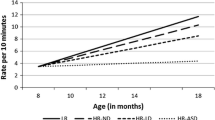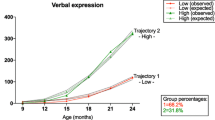Abstract
This study examined social communication profiles from behavior samples videotaped between 18 and 24 months of age in three groups of children: 50 with autism spectrum disorders (ASD), 23 with developmental delays (DD), and 50 with typical development (TD). The ASD group scored significantly lower than the DD group on 5 social communication measures and the TD group on all 14 measures, indicating distinct profiles late in the second year. Understanding was the strongest predictor of developmental level and behavior regulation and inventory of gestures were the strongest predictors of autism symptoms at 3 years of age. The predictive relations suggest five pivotal skills late in the second year that have a cascading effect on outcomes of children with ASD.
Similar content being viewed by others
References
American Psychiatric Association (1994). Diagnostic and statistical manual of mental disorders (4th ed.). Washington, D.C.: APA.
Bakeman, R., & Adamson, L. (1984). Coordinating attention to people and objects in mother–infant and peer–infant interaction. Child Development, 55, 1278–1289.
Baron-Cohen, S., Cox, A., Baird, G., Swettenham, J., Nightingale, N., Morgan, K., et al. (1996). Psychological markers in the detection of autism in infancy in a large population. British Journal of Psychiatry, 168, 158–163.
Bates, E. (1979). The emergence of symbols: Cognition and communication in infancy. New York: Academic Press.
Bono, M., Daley, T., & Sigman, M. (2004). Relations among joint attention, amount of intervention and language gain in autism. Journal of Autism and Developmental Disorders, 34, 495–505.
Bruner, J. (1981). The social context of language acquisition. Language and Communication, 1, 155–178.
Charman, T., Baron-Cohen, S., Swettenham, J., Baird, G., Drew, A., & Cox, A. (2003). Predicting language outcome in infants with autism and pervasive developmental disorder. International Journal of Language & Communication Disorders, 38, 265–285.
Charman, T., Swettenham, J., Baron-Cohen, S., Cox, A., Baird, G., & Drew, A. (1997). Infants with autism: An investigation of empathy, pretend play, joint attention, and imitation. Developmental Psychology, 33, 781–789.
Charman, T., Taylor, E., Drew, A., Cockerill, H., Brown, J., & Baird, G. (2005). Outcome at 7 years of children diagnosed with autism at age 2: Predictive validity of assessments conducted at 2 and 3 years of age and pattern of symptom change over time. Journal of Child Psychology and Psychiatry, 46, 500–513.
Chawarska, K., & Volkmar, F. (2005). Autism in infancy, early childhood. In F. Volkmar, R. Paul, A. Klin, & D. Cohen (Eds.), Handbook of autism and pervasive developmental disorders (3rd ed., pp. 223–246). New York: Wiley.
Corsello, C., Cook, E., & Leventhal, B. (2003, April). A screening instrument for autistic spectrum disorders. Poster presentation at the Biennial Conference of the Society for Research in Child Development, Tampa, FL.
Cox, A., Klein, K., Charman, T., Baird, G., Baron-Cohen, S., Swettenham, J., Wheelright, S., & Drew, A. (1999). Autism spectrum disorders at 20 and 42 months of age: Stability of clinical and ADI-R diagnosis. Journal of Child Psychology and Psychiatry, 40, 719–732.
Dawson, G., Toth, K., Abbott, R., Osterling, J., Munson, J., Estes, A., & Liaw, J. (2004). Early social attention impairments in autism: Social orienting, joint attention, and attention to distress. Developmental Psychology, 40, 271–283.
Howlin, P., & Moore, A. (1997). Diagnosis of autism: A survey of over 1200 patients in the UK. Autism, 1, 135–162.
Lord, C. (1995). Follow-up of two year-olds referred for possible autism. Journal of Child Psychology and Psychiatry and Allied Disciplines, 36, 1365–1382.
Lord, C., Rutter, M., DiLavore, P., & Risi, S. (1999). Autism diagnostic observation schedule-generic. Los Angeles, CA: Western Psychological Services.
McDuffie, A., Yoder, P., & Stone, W. (2005). Prelinguistic predictors of vocabulary in young children with autism spectrum disorders. Journal of Speech, Language, and Hearing Research, 48, 1080–1097.
McLean, J., & Snyder-McLean, L. (1999). How children learn language. San Diego: Singular Publishing.
Meltzoff, A. (2004). The case for developmental cognitive science: Theories of people and things. In: G. Bremner, & A. Slater (Eds.), Theories of infant development (pp. 145–173). Oxford: Blackwell Publishers.
Mervis, C.B., & Klein-Tasman, B.P. (2004). Methodological issues in group-matching designs: Alpha levels for control variable comparisons and measurement characteristics of control and target variables. Journal of Autism and Developmental Disorders, 34(1), 7–17.
Mitchell, S.K. (1979). Interobserver agreement, reliability, and generalizability of data collected in observational studies. Psychological Bulletin, 86, 376–390.
Mullen, E. (1995). The Mullen scales of early learning. Circle Pines, MN: American Guidance.
Mundy, P., & Burnette, C. (2005). Joint attention and neurodevelopmental models of autism. In F. R. Volkmar, R. Paul, A. Klin, & D. Cohen (Eds.), Handbook of autism and developmental disorders (3rd ed., pp. 650–681). New Jersey: Wiley.
Mundy, P., Sigman, M., & Kasari, C. (1990). A longitudinal study of joint attention and language development in autistic children. Journal of Autism and Developmental Disorders, 20, 115–128.
Osterling, J., & Dawson, G. (1994). Early recognition of children with autism: A study of first birthday home videotapes. Journal of Autism and Developmental Disorders, 24, 247–257.
Osterling, J., Dawson, G., & Munson, J. (2002). Early recognition of one year old infants with autism spectrum disorder versus mental retardation: A study of first birthday party home videotapes. Development and Psychopathology, 14, 239–252.
Rutter, M., Bailey, A., Berument, S., Lord, C., & Pickles, A. (2001). Social communication questionnaire research edition. Los Angeles, CA: Western Psychological Corporation.
Siegel, B., Pliner, C., Eschler, J., & Elliot, G. (1988). How children with autism are diagnosed: Difficulties in identification of children with multiple developmental delays. Developmental and Behavioral Pediatrics, 9, 199–204.
Sigman, M., Dijamco, A., Gratier, M., & Rozga, A. (2004). Early detection of core deficits in autism. Mental Retardation and Developmental Disabilities Research Reviews, 10, 221–233.
Sigman, M., Mundy, P., Sherman, T., & Ungerer, J. (1986). Social interactions of autistic, mentally retarded, and normal children and their caregivers. Journal of Child Psychology and Psychiatry, 27, 647–656.
Sigman, M., Ruskin, E., Arbeile, S., Corona, R., Dissanayake, C., Espinosa, M., Kim, N., Lopez, A., & Zierhut, C. (1999) Continuity and change in the social competence of children with autism, Down syndrome, and developmental delays. Monographs of the Society for Research in Child Development, 64, 1–114.
Sparrow, S. Balla, D., & Cicchetti D. (1984). Vineland adaptive behavior scales. Circle Pines, MN: American Guidance Service.
Stone, W. L., & Caro-Martinez, L. M. (1990). Naturalistic observations of spontaneous communication in autistic children. Journal of Autism and Developmental Disorders, 20, 437–453.
Stone, W., Lee, E., Ashford, L. Brissie, J., Hepburn, S., Coonrod, E., & Weiss, B. (1999). Can autism be diagnosed accurately in children under three years? Journal of Child Psychology and Psychiatry, 40, 219–226.
Stone, W., Ousley, O., Yoder, P., Hogan, K., & Hepburn, S. (1997). Nonverbal communication in 2- and 3-year old children with autism. Journal of Autism and Developmental Disorders, 27, 677–696.
Swettenham, J., Baron-Cohen, S., Charman, T., Cox, A., Baird, G., Drew, A., et al. (1998). The frequency and distribution of spontaneous attention shifts between social and nonsocial stimuli in autistic, typically developing, and nonautistic developmentally delayed infants. Journal of Child Psychology and Psychiatry, 39, 747–753.
Tager-Flusberg, H., Joseph, R., & Folstein, S. (2001). Current directions in research on autism. Mental Retardation and Developmental Disabilities Research Reviews, 7, 21–29.
Volkmar, F., Lord, C., Bailey, A., Schultz, R., & Klin, A. (2004). Autism and pervasive developmental disorders. Journal of Child Psychology and Psychiatry, 45, 135–170.
Werner, E., & Dawson, G. (2005). Validation of the phenomenon of autistic regression using home videotapes. Archives of General Psychiatry, 62, 889–895.
Werner, E., Dawson, G., Munson, J., & Osterling, J. (2005). Variation in early developmental course in autism and its relations with behavioral outcome at 3–4 years of age. Journal of Autism and Developmental Disorders, 35, 337–350.
Wetherby, A. (1986). The ontogeny of communicative functions in autism. Journal of Autism and Developmental Disorders, 16, 295–316.
Wetherby, A., Allen, L., Cleary, J., Kublin, K., & Goldstein, H. (2002). Validity and reliability of the Communication and Symbolic Behavior Scales Developmental Profile with very young children. Journal of Speech, Language, & Hearing Research, 45, 1202–1218.
Wetherby, A., Goldstein, H., Cleary, J., Allen, L., & Kublin, K. (2003). Early identification of children with communication disorders: Concurrent and predictive validity of the CSBS Developmental Profile. Infants and Young Children, 16(2), 161–174.
Wetherby, A., & Prizant, B. (1993). Communication and symbolic behavior scales—Normed edition. Baltimore, MD: Paul H. Brookes.
Wetherby, A., & Prizant, B. (2002). Communication and symbolic behavior scales developmental profile—First Normed edition. Baltimore, MD: Paul H. Brookes.
Wetherby, A. M., Prizant, B.M., & Hutchinson, T. (1998). Communicative, social-affective, and symbolic profiles of young children with autism and pervasive developmental disorder. American Journal of Speech-Language Pathology, 7, 79–91.
Wetherby, A., Woods, J., Allen, L., Cleary, J., Dickinson, H., & Lord, C. (2004). Early indicators of autism spectrum disorders in the second year of life. Journal of Autism and Developmental Disorders, 34(5), 473–493.
Williams, J., Whiten, A., & Singh, T. (2004). A systematic review of action imitation in autism spectrum disorder. Journal of Autism and Developmental Disorders, 34, 285–299.
Wimpory, D. C., Hobson, R. P., Williams, J. M. G., & Nash, S. (2000). Are infants with autism socially engaged? A study of recent retrospective parental reports. Journal of Autism and Developmental Disorders, 30, 525–536.
Yoder, P., & Warren, S. (1999). Maternal responsivity mediates the relationship between prelinguistic intentional communication and later language. Journal of Early Intervention, 22, 126–136.
Acknowledgments
This research was supported in part by two grants from the U.S. Department of Education, Office of Special Education and Rehabilitation Services (H324M010071 and H324C030112) and a grant from the U.S. Department of Education, Institute of Education Sciences (R305T010262). The authors would like to thank the families who gave their time to participate in this project.
Author information
Authors and Affiliations
Corresponding author
Rights and permissions
About this article
Cite this article
Wetherby, A., Watt, N., Morgan, L. et al. Social Communication Profiles of Children with Autism Spectrum Disorders Late in the Second Year of Life. J Autism Dev Disord 37, 960–975 (2007). https://doi.org/10.1007/s10803-006-0237-4
Published:
Issue Date:
DOI: https://doi.org/10.1007/s10803-006-0237-4




